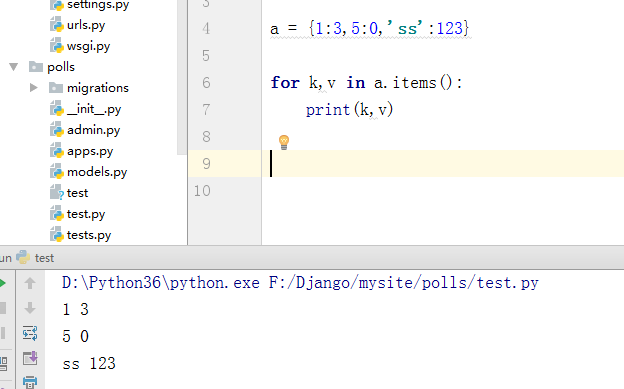1、python字典的定义
1、用大括号{},以逗号分隔每个键值对,键与值之间用冒号连接
2、键:需要不可变的数据结构,值可以是任意的数据对象
3、字典是无序的,键在字典中必须是唯一,在字典中取值的方式是以键寻找相对应的的值
a = {} c = dict() a {} c {} b = {'a':'hello','c':'you','b':'how'} a = [1,2,3] b = ['a','b','c'] d = dict(zip(a,b)) d {1: 'a', 2: 'b', 3: 'c'} 给字典中的项value赋值 a = {1:23} a[1] = 3 a {1: 3} 字典的访问 b {'a': 'hello', 'c': 'you', 'b': 'how'} b.get('a') 'hello'
增: fruits {'a': 'apple', 'b': 'banana', 'g': 'grape', 'o': 'orange'} fruits.setdefault('martin',20) 20 fruits.setdefault('a','appleaaa') 'apple' fruits {'a': 'apple', 'b': 'banana', 'g': 'grape', 'o': 'orange', 'martin': 20} fruits.update({3:5}) fruits.update({'a':'appleupdate'}) fruits {'a': 'appleupdate', 'b': 'banana', 'g': 'grape', 'o': 'orange', 'martin': 20, 3: 5} 2) setdefault:参数是key和value,如果key不存在,在添加key:value,如果key存在,什么也不做。 3) update:参数是key和value,不管key存不存在,都变成 key:value的形式。 删除(工作中不常用) fruits {'a': 'appleupdate', 'b': 'banana', 'g': 'grape', 'o': 'orange', 'martin': 20, 3: 5} fruits.pop(3) 5 fruits {'a': 'appleupdate', 'b': 'banana', 'g': 'grape', 'o': 'orange', 'martin': 20} 改: 1、赋值 2、update a {2: 9, 3: 5, 4: 9} a[0] = 8 a {2: 9, 3: 5, 4: 9, 0: 8} a[2] = 8 a {2: 8, 3: 5, 4: 9, 0: 8} a.update({3:10}) a {2: 8, 3: 10, 4: 9, 0: 8} 查 a {2: 8, 3: 10, 4: 9, 0: 8} a.get(2) 8 a[0] 8 两种取值的区别: 当key不存在的时候,get不会报错, 通过[key]方式去取值的时候,会报错
字典的遍历 1、for item in _dict: print itme 2、for k,v in a.items(): print k,v a = {1:3,5:0,'ss':123} for item in a: print(item) a = {1:3,5:0,'ss':123} for k,v in a.items(): print(k,v)
当把字典当成序列的时候,指的是key组成的序列

超市购物
#coding:gbk import sys food_price = {'apple':5, 'orange': 8, 'banana':3, 'beef':40, 'pork':26, 'cocacola':3} while True: try: money = int(input('pls input your money: ')) break except: print('your input in not conrrect,pls input a number') shooping_list = [] while True: print(' 目前可购买的商品:') for food,price in food_price.items(): print(food,price) if money < min(food_price.values()): print(' sorry,you have not enough money to buy any food ') if shooping_list: print(' 你已经买了如下商品: %s' %shooping_list) print(' 你现在有%s,选择一支商品吧' % money) _choice = input(' pls input your choice:') choice = _choice.strip() if choice in ['quit','exit','q']: print(' 你已经买了如下商品 %s' %shooping_list) sys.exit() if choice not in food_price: print(' 你已经买了如下商品 %s' %shooping_list) continue price = food_price[choice] print(' 你选择的商品:%s的价格:%s' %(choice,price)) if money >= price: shooping_list.append(choice) money = money - price print(' 你的余额是 %s ' % money) else: print(' sorry,买不起,您剩余:%s$, %s 的价格是 %s $, 真穷!' % (money, choice, price))